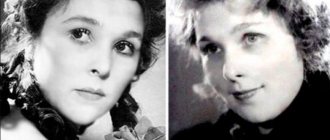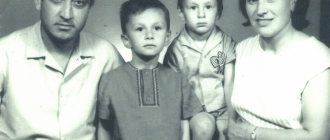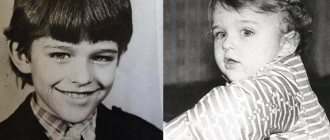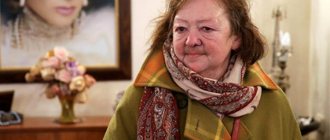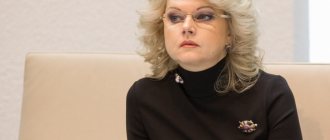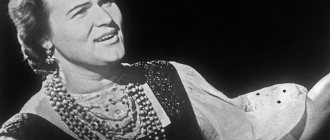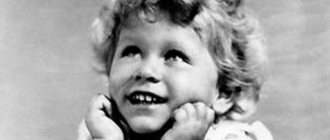Childhood
Vera was born on August 5, 1893 in the city of Poltava. Her maiden name was Levchenko.
The family where the girl was born was educated and intelligent. Father, Vasily Andreevich Levchenko, taught literature at the city gymnasium. Mom, Ekaterina Sergeevna Levchenko (maiden name Sleptsova), graduated from the Alexander-Mariinsky Institute of Noble Maidens. During her marriage, she took care of the housework and raising her daughters; in addition to Vera, there were two younger girls in the family - Sofia and Nadezhda.
When Vera was two years old, her maternal grandfather passed away. Grandmother Ekaterina Vladimirovna, remaining a widow, asked her daughter and son-in-law to move to Moscow with her. Levchenko moved from Poltava and settled in one of the houses on Kislovsky Lane. Here they were supported by numerous relatives, the family lived in abundance, which made it possible to often organize evenings and receive guests.
Then it was fashionable to play charades and “living pictures”, when some participants showed some words or plots in the form of a skit, while others guessed. Little Vera loved to participate in such evenings. Moreover, the girl carefully prepared for such games. She learned to read early, so she looked for plots for “live games” in books and rehearsed them with her dolls. In addition, the baby, like her dad, sang excellently.
She grew up quiet and very obedient. At the same time, the younger sisters were a little afraid of Vera because of her selfless daydreaming; she seemed out of this world. One day the girls heard their older sister, with rapture, wild gestures and drama, telling the dolls a story she had read about sea adventures. They thought then that Vera was crazy and was talking to herself.
Education
When the girl was ten years old, she was sent to study at the private Perepelkina gymnasium. One day they and their class were taken to the Bolshoi Theater, after which Vera fell ill with ballet. She persuaded her mother to allow her to study at the ballet school at the Bolshoi Theater. The mother did not object because she was sure that her daughter would not be accepted there. Although Vera was graceful, she was not thin; for her slight plumpness and excellent appetite, her mother even called her daughter “Poltava dumpling.” But the girl passed the exam perfectly, delighting the teachers with her extraordinary grace. Having beaten many competitors, Vera was enrolled in the ballet school.
But then grief happened in the family: the father died of lobar pneumonia. After his death, his mother began to get very sick, and worries about her younger sisters fell entirely on Vera’s shoulders.
At the same time, the grandmother imperiously intervened in the fate of her granddaughter, who considered it unacceptable for a girl from a decent family to jump on stage. Ekaterina Vladimirovna was categorically against an artistic future for her granddaughter. Even the persuasion of a distant relative of the famous Russian theater actress Elena Leshkovskaya did not help. After studying for a year at the ballet school, Vera returned to the gymnasium. In the future, she very much regretted her unfulfilled dream and reproached her mother for allowing her grandmother to snatch Vera from ballet art.
In the fall of 1908, the St. Petersburg theater toured Moscow, and Vera attended a production of Gabriele D'Annunzio's play Francesca da Rimini. The main role was played by the great Russian dramatic actress Vera Komissarzhevskaya. The fifteen-year-old girl was so shocked by her performance that upon returning home she developed a high fever. The family doctor who came explained that this was due to excessive impressionability; the young lady should dream and read less.
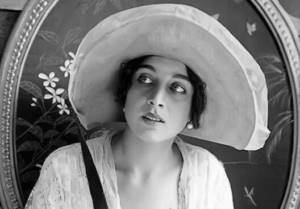
Mother forced Vera to change her hobbies. Now in the winter she spent a lot of time with her sisters at the skating rink, and in the summer at the dacha in Zelenograd she mastered the game of tennis. But in her heart the girl did not change her preferences. The theater fascinated her more and more. She began to often perform at school evenings, reading poetry from the stage and playing the piano excellently. And then I tried myself in a theater production. At the gymnasium they staged “The Dowry” by A. N. Ostrovsky, and Vera got the role of Larisa. She played so soulfully that people in the hall gave a standing ovation. The audience did not even feel that in front of them was not a professional actress, but an ordinary teenage girl.
Virus or poisoning?
On the evening of February 16, a week later, Vera died. What killed the greatest actress of the time: flu or poison? An autopsy was not performed, so it is impossible to find out what really happened. Of course, modern technology could help find out the truth, but the body was lost when the cemetery was ravaged in 1932.
Vera’s sister, daughter and mother returned to Moscow a week later. Then Vladimir learned about his wife’s death. The news shocked the man so much that he locked himself in his office for several days, talked to the portrait of Vera and asked for his forgiveness. Vladimir was never able to survive the death of his beloved woman. He died three months after Vera. According to another version, he was nevertheless shot by the Bolsheviks.
Anna Rusich
Interesting story Movies and TV series Our heroes show business
Marriage
In 1910, Vera shone at the gymnasium graduation party to mark the end of her studies. It was here that her fateful acquaintance with a handsome Moscow University student, Vladimir Kholodny, who was studying to become a lawyer, took place. They danced a lot, and in the end, secluded in the corner of the huge hall, Volodya began to recite the poetry of Nikolai Gumilyov to the girl. The poems completely melted the heart of the young beauty. Kholodny seemed to Vera to be a wonderful knight. She fell in love with him so much that she did not even hide her happy state from others.
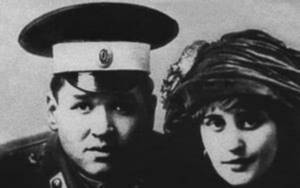
Vladimir was also captivated by the black-haired beauty with bottomless eyes. The relationship that began at the prom soon developed into a strong feeling. Vera and Volodya could not live a day without each other. Kholodny proposed marriage to his beloved. She agreed with joy, but then obstacles began from relatives. Mom and grandmother were not delighted with the young future lawyer; they wanted a more worthy match for Vera. Vladimir’s grandfather and father also rebelled against early marriage.
But the beautiful tender feeling turned out to be stronger. Despite the resistance of relatives, the wedding date was set. On this day, Vera was absolutely happy, although a little sad, her romantic soul was weighed down by the guests, the noise of the feast and rude jokes with toasts.
Vladimir rented a small apartment where the newlyweds settled. Vera tried to help her husband in everything, and it was thanks to her that he graduated from the university with honors. However, having started working at a Moscow law firm, Vladimir soon lost interest in jurisprudence.
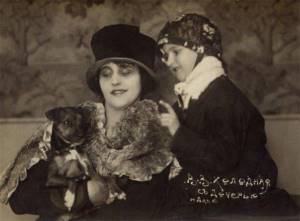
He began publishing the first Russian newspaper for car enthusiasts called “Auto”. And then Kholodny became seriously interested in car racing. Vera considered this activity extremely dangerous, but still supported her husband, which was proof of her boundless love. He was injured twice in accidents. And she, knowing for sure that after recovery her husband would drive again, nursed him with warmth and tenderness.
In 1912, the Kholodnys had a daughter, Zhenya. After a difficult birth, Vera was ill for a long time, and in the next few years doctors forbade her to give birth again. When Zhenya was naked, Volodya and Vera adopted a girl left without parents. This is how the second daughter Nonna appeared in their family.
But the happy life ended with the First World War. Vladimir volunteered for the front, leaving his wife and small daughters. Vera was faced with a lot of worries; she had to manage the household economically in order to stretch out the money left by her husband as long as possible.
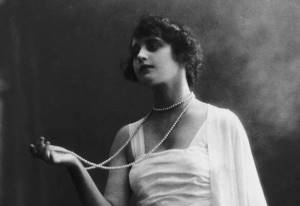
First film auditions
Even at the beginning of her family life, Vera often took her husband to the theater in the evenings. But even more often they went to Sadovaya Street to the Buff cinema. Cinema was just beginning to gain popularity in Russia. After watching the film “The Abyss,” Kholodnaya was delighted with the Danish actress Asta Nielsen. After that, Vera did not miss a single film with her participation. And when she came home, she froze for a long time in front of the mirror, looking at her reflection. The husband saw that his wife’s passion for cinema was manic.
After the birth of my daughter, my passion for cinematography faded into the background. And when Vladimir went to war and Vera was left alone with her daughters, cinema burst into her life again, becoming the only joy that at least slightly distracted the young woman from everyday problems.
While her husband was at war, her mother and her sisters Nadya and Sonya moved in with Vera. The money was running out, and Kholodnaya decided to look for work. When the war began, Russia stopped purchasing foreign films, which had a positive effect on the development of domestic cinema. Studios were opened in Moscow and St. Petersburg, which produced a stream of heart-warming love stories. They did not always involve professionals, so at the entrance to the film studio there were often notices with an invitation to participate in filming for a monetary reward.
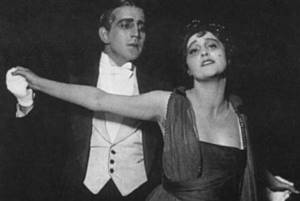
Vera also went to one of these studios for a screen test. Director Vladimir Gardin drew attention to the young, beautiful and spectacular woman. In 1914, he entrusted her with the small role of an Italian nurse in the film Anna Karenina. After filming, Gardin said that Vera was unlikely to make an actress, since apart from her stunning appearance, no other talents were discovered in her. Kholodnaya was upset and left her dream of acting alone for a while.
A bright but short creative path
Even at the beginning of her marriage, Vera became a regular at the Alatr artistic circle, which was quite popular in Moscow. She came here even in the most difficult times. In 1915, in a circle, Kholodnaya met director Evgeniy Bauer, who worked at the film studio of Alexander Khanzhonkov. Evgeny was just about to shoot the film “Song of Triumphant Love” and invited Vera to play the main role. Bauer was a professional decorator, so in his works he focused not on the performing ability of the actress, but on her external data.
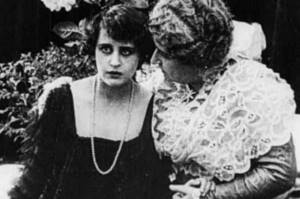
“Song of Triumphant Love” was an incredible audience success, and Vera Kholodnaya, who instantly became a star, literally hypnotized the whole of Russia. Studio director Khanzhonkov foresaw such success even at the time of filming and signed a three-year contract with the actress. In the same 1915, she played in several more films:
- "Moon Beauty";
- “Beauty should reign in the world”;
- "Children of the Century";
- "Awakening";
- “Children of Vanyushin”;
- "Flame of the Sky"
By 1916, Kholodnaya already occupied the status of a first-rate movie star in Russia. Huge queues formed outside the cinemas, people stormed the box office and halls, sometimes even breaking windows and tearing doors off their hinges. Thanks to the actress Kholodnaya, the country began to try a voluptuous drug called “cinema.” The charming Vera took people with her into the world of dreams, and the people longed for this again and again.
For a long time she herself did not believe in such fame. Sometimes she dressed discreetly and, with her younger sister Sonya, went to the most remote area of Moscow to watch the audience’s reaction to her performance in the cinema.
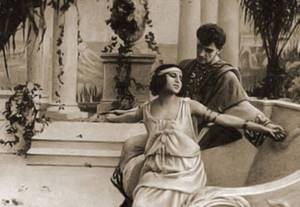
Kholodnaya repeatedly received offers to move to Europe. She was invited to join the troupe of his theater by Stanislavsky himself. Everyone with whom she worked, and at whom she only cast a fleeting glance, fell in love with Vera. She had a lot of fans, but she never cheated on her beloved husband. When he was seriously wounded at the front, Vera quit filming and rushed to the hospital to nurse her Volodya.
In 1916, she moved from Khanzhonkov to the film studio of Dmitry Kharitonov, where she starred in more than twenty films, the most famous of which:
- "Chess of Life";
- "Capital Poison";
- "For the sake of happiness";
- "By the fireplace";
- “Forget about the fireplace, the lights have gone out.”
Movies
Vera Kholodnaya's film debut occurred in 1914. Director Vladimir Gardin was attracted by the girl’s spectacular appearance, and he cast her in the role of an Italian nurse in his film “Anna Karenina”. It is noteworthy that after working together, Gardin said that Kholodnaya would not make an actress, since she had nothing except her appearance.
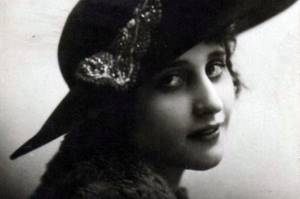
However, within a year Vera’s career took off. Another director cast her in the melodrama “Song of Triumphant Love” based on Turgenev’s work, which created a real sensation. According to Alexander Vertinsky, this film is the pinnacle of the actress’s success. At the same time, Kholodnaya starred in several more films, and played not only young beauties. For example, in “Moon Beauty” she appears in the guise of an elderly lady wearing a gray wig.
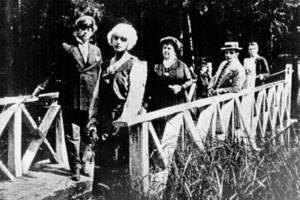
In total, Vera Kholodnaya starred in more than 40 films over 5 years. But two other points are noteworthy. Firstly, at that time it was not customary to announce films; on the contrary, even the names of films being filmed were hidden so that competitors would not intercept the idea and plot. But Vera Kholodnaya’s participation in the filming turned this practice upside down. The audience went specifically to see her, so we can say that it was Vera who became the first Russian movie star.
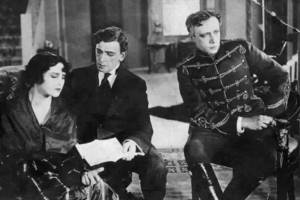
Secondly, together with Vitold Polonsky and Vladimir Maksimov, Kholodnaya formed a permanent trio with screen images assigned to them, again, becoming the first Russian actress with a strictly defined role. The first joint film of the three popular artists was the film “By the Fireplace,” the action of which was based on a love triangle. The film was a huge success, so it was soon followed by a sequel, “Forget about the fireplace, the lights went out in it...”.
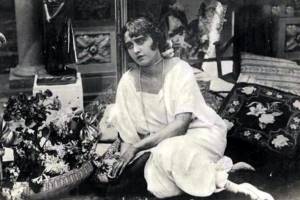
Vera Kholodnaya's film career continued throughout the First World War, and even the October Revolution did not force her to stop her activities. Moreover, in Odessa, where the actress has been filming in recent years, in conditions of strict energy savings, the new authorities allowed the film studio to use film and electricity in unlimited quantities, but “only if Vera Kholodnaya is being filmed.” In Odessa, the actress managed to play in four films: “Princess Tarakanova”, “The Woman Who Invented Love”, “Last Tango” and “Azra”.
Death
In the summer of 1918, the actress went to Odessa to complete filming in the films “Gypsy Aza” and “Princess Tarakanova.” Her younger sister Sonya, daughter Zhenya and mother went with her. The husband, who by that time had been discharged due to a serious injury, remained in Moscow.
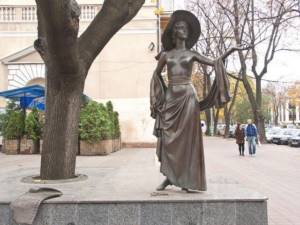
At the beginning of 1919, an epidemic of severe influenza, popularly called “Spanish flu,” hit Odessa. Vera, who had the flu, began to develop pulmonary complications. The doctors did everything to save the actress, but on February 16, 1919, her heart stopped.
The actress's body was embalmed in order to be transported to Moscow for burial. But the war was going on, the roads were blocked, Vera Kholodnaya was buried in Odessa. However, this cemetery was destroyed in 1932, a park was laid out in its place, and the grave of the great actress has not survived to this day. Opposite the house where she lived and died in Odessa, there is a beautiful bronze monument.
A month later, Vera’s mother died of typhoid fever, and in the same year, Vladimir Kholodny was shot by security officers. Daughters Zhenya and Nonna were taken to her by sister Nadezhda.
“A Life for a Life” (1916), directed by Evgeniy Bauer
Thanks to this film, one can compare the performances of professional theater actress Lidiya Koreneva (in the role of Musya Khromova) and Vera Kholodnaya (Nata Khromova). Critics believed that Vera outplayed Lydia, but, in our opinion, this is not entirely true, Koreneva is certainly a very talented actress, and her performance looks quite modern, while Vera Kholodnaya, in comparison, caricatures her hands and rolls her eyes . In this film it is also interesting to watch the performances of Olga Rakhmanova (Musya’s mother and Nata’s adoptive mother) and Ivan Perestiani (merchant Zhurov). The credits also include the artist (director and costume designer) - Alexey Utkin . After the revolution, he would make a good career in Soviet cinema, among the interesting films with his participation we will name “Jolly Fellows” (1934), “At the Order of the Pike” (1938), “The Little Humpbacked Horse” (1941).
The costumes in the film are excellent, Gromov’s mother is dressed a little old-fashioned - she wears a corset, the skirt is longer, the silhouette of her dresses is more fitted, which was fashionable at the beginning of the century. Her daughters dress in white lace multi-layered dresses for the holiday, and at home they wear white blouses and dark skirts. Nata's wedding dress is curious: with a low waistline, it is closer to the fashionable rectangular silhouettes of the 1920s. The sister-brides have their heads covered with veils, on top of which they wear modest flower crowns. Having successfully married, Nata dresses more interestingly than as a girl: she has a fancy hat with feathers, a cloak with frills, a lace dress with embroidery and frills. In dramatic scenes, the heroine Kholodnaya, as usual, wears black, which emphasizes her experiences and suffering.
